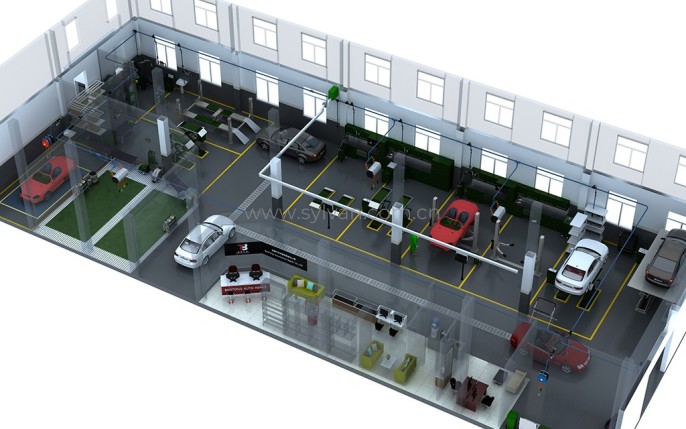Imagine stepping into a well-organized workshop, where every tool is within reach, every vehicle can be accessed smoothly, and workflow moves like clockwork. This isn’t a dream, but the reality many shops experience thanks to a carefully planned and executed floor plan. The layout of your automotive workshop isn’t just about aesthetics; it’s the backbone of efficiency, safety, and ultimately, your profitability.

Image: www.pinterest.com
A thoughtfully designed floor plan can maximize space, optimize workflows, enhance safety, and improve customer experience. This article will guide you through the key considerations and best practices to create an optimal floor plan for your automobile workshop, one that will empower you to operate more efficiently and seamlessly.
Defining the Blueprint for Success: Fundamental Considerations
Understanding Your Needs: Identifying Your Workshop’s Heartbeat
A successful floor plan starts with a deep understanding of your specific needs. The first step is to define your core services. What types of vehicles do you specialize in? Do you focus on repairs, maintenance, or both? The answers determine the necessary space for different workstations, equipment, and storage.
Mapping the Workflow: Designing Efficient Processes
Visualize the journey of a vehicle from the moment it enters your shop to the completion of the work. Consider:
- Reception/Customer waiting area: This area should be welcoming and easily accessible.
- Workstations: Allocate space for distinct bays for different tasks – engine repair, bodywork, electrical work, etc.
- Storage: Ensure adequate space for parts, cleaning supplies, tools, and equipment.
- Office and Staff Area: Provide a dedicated space for administrative tasks and staff breaks.

Image: www.sylvan.com.cn
Safety First: Prioritizing a Secure Environment
A well-designed floor plan promotes safety. Minimize trip hazards, optimize lighting, ensure clear pathways for pedestrian and vehicle traffic, and position fire extinguishers strategically.
Planning the Layout: A Step-by-Step Guide
Start with the Basics: Floor Area and Space Allocation
The first step is to understand your available square footage. This includes the total area of your workshop and the dimensions of any pillars, columns, or other obstacles. Then, create a rough sketch of the space, outlining potential areas for workstations, storage, and other amenities.
Defining Zones: Creating a Functional Layout
Divide your workshop into distinct zones with specific functions:
- Service Zone: Contains your service bays, lifting equipment, and tools for vehicle maintenance and repair.
- Inspection Zone: A dedicated area for vehicle inspection upon arrival.
- Parts Zone: Contains your inventory, storage, and possibly a parts counter for customer interaction.
- Cleaning Zone: A dedicated area for cleaning and detailing vehicles and equipment.
Workflow Optimization: Ensuring Streamlined Operations
The layout of your workstations and flow of traffic play a significant role in efficiency.
- Logical Flow: Design your layout so vehicles can move smoothly through the workshop from reception to service bays, parts zone, and finally, exit.
- Minimizing Backtracking: Locate frequently used tools and parts in close proximity to the most used workstations to minimize wasted time and movement.
Leveraging Technology: Utilizing Digital Tools for Design
In today’s digital age, there are a plethora of tools available to assist you in designing your floor plan:
<ul>
<li><strong>CAD Software:</strong> Computer-aided design (CAD) software like AutoCAD or SketchUp allows you to create detailed 2D and 3D drawings of your workshop, including walls, equipment, and furniture.
</li>
<li><strong>Floor Planning Apps:</strong> Many user-friendly mobile apps offer intuitive interfaces and pre-built templates to create basic layouts.
</li>
</ul> Building Your Workshop: From Design to Reality
Choosing the Materials: Ensuring Functionality and Durability
The choice of flooring for your automotive workshop is critical. Factors to consider:
- Durability: Look for flooring resistant to grease, oil, chemicals, and abrasion.
- Slip Resistance: Ensure the chosen material provides a slip-resistant surface, especially in wet areas.
- Easy Cleaning: Select a flooring material that can be easily cleaned and maintained.
Lighting Up Your Space: Creating a Well-Illuminated Workspace
Adequate lighting is essential for accurate vehicle repair and inspection.
- General Lighting: Ensure bright, even lighting throughout the workshop using overhead fluorescent lights or LED fixtures.
- Task Lighting: Provide additional lighting for specific workstations such as under-hood lights or work lamps to enhance visibility during detailed tasks.
Storage Strategy: Creating Order Out of Chaos
Effective storage is vital for maintaining a tidy workshop and maximizing space.
- Wall-mounted Storage: Utilize wall shelves, pegboards, and tool cabinets to maximize vertical space.
- Rolling Cabinets: Employ rolling cabinets for frequently used tools and equipment, allowing for easy movement and organization.
- Parts/Inventory Storage: Design dedicated areas with shelving units, drawers, or bins to store parts and supplies efficiently.
The Final Touches: Enhancing Functionality and Aesthetics
Organization is Key: Implementing a System for Success
A well-organized workshop fosters efficiency and productivity. Assign designated spaces for tools and equipment, label shelves and bins, and implement a system for returning tools to their designated locations after use.
Ergonomics Matters: Designing a Comfortable Workspace
Focus on the comfort and well-being of your mechanics. Ensure ergonomic chairs and workstations, and provide proper lighting and ventilation to make work more comfortable.
Safety Measures: Prioritizing a Secure Environment
Regular inspections, safety training for staff, and maintaining clear pathways for vehicle and pedestrian movement are essential for a safe workshop environment.
Automobile Workshop Automotive Workshop Floor Plan Layout
Conclusion: Building a Workshop for Success
A well-designed floor plan is the foundation for a thriving automobile workshop. It promotes efficiency, safety, and customer satisfaction. By carefully considering your needs, utilizing technology, prioritizing safety, and focusing on organization, you can create a workshop that empowers you to succeed. It’s about optimizing every inch of space, streamlining workflows, and creating a seamless experience for your team and your clients. Remember, a well-planned workshop is more than just a physical space – it’s an investment in your business’s future.





